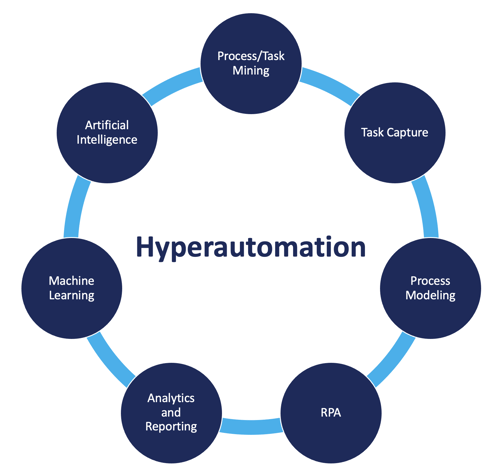Hyperautomation: What is it? And Why does it matter?
A Guide to Everything You Need to Know About Hyperautomation
Hyperautomation first entered the enterprise lexicon when Gartner included it in the lead spot for their top 10 strategic trends for 2020 and it’s no surprise that it’s also present in Gartner’s top 10 strategic trends for 2022. As hyperautomation continues to grow in popularity, people still struggle to capture exactly what it refers to—is it simply automation, but faster? A closer look at Gartner’s definition of hyperautomation suggests otherwise.
What is Hyperautomation?
Hyperautomation is the implementation of an end-to-end automation toolchain. It allows organizations to automate more complex and complete business processes instead of only parts of them.
The technology to create a hyperautomation ecosystem includes the adoption of artificial intelligence (AI) and machine learning (ML) technologies like natural language processing (NLP) and optical character recognition (OCR) to augment business processes.
“Hyperautomation is the combination of multiple machine learning (ML), packaged software, and automation tools to deliver work. Hyperautomation refers not only to the breadth of the pallet of tools but also to all the steps of automation itself (discover, analyze, design, automate, measure, monitor, and reassess).”
Gartner®
An extensive hyperautomation toolchain would contain tools for all of the following components:
 |
Process/Task Mining – Software that combs through event logs and finds undiscovered processes and process variants that might be good candidates for automation. |
| Task Capture – Recorders that sit on workers’ desktops and manually capture the processes and tasks your employees follow to identify good RPA opportunities and build the initial process for automation. | |
| Process Modeling – A centralized repository that can store all your as-is processes. It should also provide a process editor that enables your stakeholders to design and optimize your to-be automated processes. Additionally, any robust process modeling solution allows you to connect processes to all critical information like regulations, legacy systems, and more to facilitate change management and automation governance. | |
 |
RPA Platform – A platform where your automation engineers can develop and deploy bots. |
|
|
Analytics & Reporting – While most RPA platforms provide monitoring and analytics features, this capability is key to measure your ROI and gain insight into your automated business processes like which are running the most, when, and which are error-prone? |

Hyperautomation isn’t limited to just the tools needed to carry out automation; it also refers to establishing protocols for every step of automation. Including process discovery, process optimization, design, planning, development, deployment, and monitoring.
RPA vs. Hyperautomation - What's the Difference?
One misconception about hyperautomation is that it competes with RPA. RPA vs. hyperautomation is not how these concepts are interrelated. Instead, think of Robotic Process Automation as a piece of the larger hyperautomation puzzle.
RPA is the automation of simple, repetitive rules-based tasks. The majority of automated processes that organizations have in production right now are not end-to-end, multi-layered processes; they’re subsets of decomposed, much larger processes.
A good example and common automation many organizations have in production is the extraction of information from invoices. In this case, a bot extracts specific components of customer information from invoices and enters them into a system of record. This data extraction is a sub-process of a much larger one that contains all the steps for processing an invoice. While having this sub-process performed using RPA ensures the task is executed quicker and with greater accuracy, it hasn’t automated the entire process.
How does hyperautomation work? Under a hyperautomation model, every part of invoice processing that could be automated using the different technologies of a hyperautomation toolchain would be automated. For example:
- A task capture tool might be used to define the flow employees follow to process invoices.
- A process modeling tool would then be used to capture and store the process and allow business and IT stakeholders to optimize it, connect it to all dependencies, and prioritize it for development.
- Machine learning might be used to review the invoice for compliance.
- Decision modeling software could also be used to automate the checks that managers or finance teams would perform manually, and so on, until as much of the process as possible was automated.
Blueprint's Platform: Your Hyperautomation Engine
Large enterprises with the intent of scaling their RPA initiatives to automate everything possible and achieve hyperautomation, need platforms like Blueprint to facilitate enterprise-scale automation planning, design, governance, and change management.
Blueprint's Platform is a centralized, cloud-based solution that enables hyperautomation with 2x faster bot design and automations that experience 3x less errors. Our platform is purpose-built to slide into the middle of your hyperautomation ecosystem and consolidated your entire RPA estate so you can manage all your automation efforts with global visibility. In Blueprint, all your stakeholders can converge to capture, design, optimize, prioritize, and manage automations.
Download the Enable Hyperautomation datasheet and discover how Blueprint can enable hyperautomation for your RPA program and increase ROI.
Share this
Recent Stories

Hyperautomation: The Next Stage of RPA Evolution

Unlocking Efficiency: Key Research Insights on RPA Bot Migration



